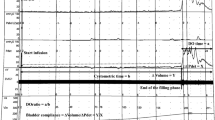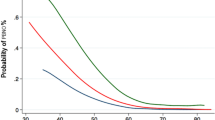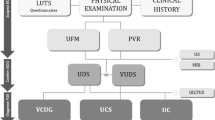Abstract
I report here the use of a crystal chisel contact tip firing Nd:YAG laser for transurethral sphincterotomy in 76 consecutive spinal cord injury patients. Their mean age was 53 years (range 26 to 77 years). Fifty-four (72%) were complete motor (Frankel A and B) and 21 (28%) were incomplete lesions (Frankel C and D) They were evaluated with multichannel urodynamic equipment and 89% of the patients showed detrusor sphincter dyssynergia and 11% showed detrusor areflexia. Forty-three patients (56%) had previous electrocautery sphincterotomy and were not voiding well. A cystoscopic examination showed that 32% had an associated enlarged prostate and/or bladder-neck stenosis and 32% had associated wide-body strictures in the bulbous urethra. The crystal chisel contact tip-firing Nd:YAG laser almost mimicked a hot diathermy knife to create an intraurethral incision as well as vaporizing the tissues. For sphincterotomy, a 12 o'clock incision was used from the verumontanum to the bulbous urethra. In patients with an associated enlarged prostate or bulging lateral lobes, 3 and 9 o'clock incisions were also made from the bladder-neck to the verumontanum and also vaporized the bulging prostate tissue. We used 25 to 40 watts for cutting, and vaporization of tissue and 15-25 watts to stop bleeding. The blood loss was less than 50 ml at surgery in 97.4% patients. None of the patients were transfused. An indwelling Foley catheter was usually left in situ for about 24 h and the majority of the patients were discharged the next day. All patients have been followed up at least every 6 months for a mean period of 27 months (range 16 to 41 months). The durability of surgery has been checked with linear array transrectal sonography and by urodynamic evaluation. Sixty-nine patients (92%) had adequate voiding, minimal to absent autonomic dysreflexia and no significant symptomatic urinary tract infection. There were seven patients who required repeat laser surgery within 2 to 5 months. All subsequent patients are voiding well with wide open bladder-neck and posterior urethra as shown on a voiding cystourethrogram.
Similar content being viewed by others
Log in or create a free account to read this content
Gain free access to this article, as well as selected content from this journal and more on nature.com
or
References
Brindley G S . The first 500 patients with sacral root stimulator implants. Paraplegia 1994; 32: 795–805.
Chancellor M F et al. Multicentral trial in North America of UroLume urinary sphincter prosthesis. J Urol 1994; 152: 924–930.
Perkash I . Detrusor-sphincter dyssynergia and dyssynergic responses: recognition and rationale for early modified transurethral sphincterotomy in complete spinal cord injury lesions. J Urol 1978; 120: 469–474.
Dykstra D D et al. Effects of botulinum A toxin on detrusorsphincter dyssynergia in spinal cord injury patients. J Urol 1988; 139: 919–922.
Perkash I . Modified approach to sphincterotomy in spinal cord injury patients: Indications, technique and results in 32 patients. Paraplegia 1976; 13: 247–260.
Schurch B, Yasuda K, Rossier A B . Detrusor bladder neck dyssynergia revisited. J Urol 1994; 152: 2066–2070.
Lockhardt J L, Vorstman B, Weinstein D, Politano V A . Sphincterotomy failure in neurogenic bladder disease. J Urol 1986; 135: 86–89.
Perkash I . Sphincterotomy and ablation of prostate using crystal chisel contact top firing neodymium: YAG laser. J Urol 1994; 152: 2020–2024.
Perkash I . Principles of Modern Urodynamic Studies. Reprinted from Investigative Radiology 1987; 22: 279–289.
Perkash I, Friedland G W . Transrectal ultrasonography of the lower urinary tract: Evaluation of bladder neck problems. Neurourology and Urodynamics 1986; 59: 453–455.
Ross J C, Damanski M, Gibbon N . Resection of the external urethral sphincter in the paraplegic-preliminary report. Transactions of the American Association of Genito-Urinary Surgeons 1957; 49: 193–198.
Ross J C, Gibbon N O K, Damanski M . Division of the external sphincter in the treatment of the neurogenic bladder. A ten-year review. British Journal of Surgery 1967; 54: 627–628.
Quesada E M, Scott F B, Cardus D . Functional classification of neurogenic bladder dysfunction. Arch Phys Med 1968; 49: 692–697.
Vapnck J M, Couillard D R, Stone A R . Is sphincterotomy the best management of the spinal cord injured bladder? J Urol 1994; 151: 961–964.
Author information
Authors and Affiliations
Rights and permissions
About this article
Cite this article
Perkash, I. Contact laser sphincterotomy: further experience and longer follow-up. Spinal Cord 34, 227–233 (1996). https://doi.org/10.1038/sc.1996.42
Issue date:
DOI: https://doi.org/10.1038/sc.1996.42
Keywords
This article is cited by
-
Update on bladder evaluation recommendations and bladder management guideline in patients with spinal cord injury
Current Bladder Dysfunction Reports (2007)



